The Diabetic Ketoacidosis Treatment Market is estimated to be valued at USD 4.1 billion in 2025 and is projected to reach USD 7.2 billion by 2035, registering a compound annual growth rate (CAGR) of 5.7% over the forecast period.
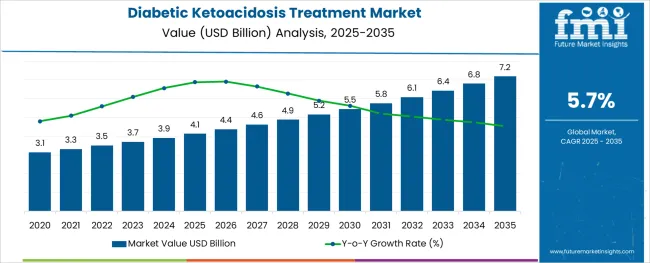
The diabetic ketoacidosis treatment market is growing steadily due to the increasing prevalence of diabetes worldwide and the need for effective management of acute complications. Growing awareness about diabetic ketoacidosis and improvements in early diagnosis have led to timely treatment interventions that reduce mortality and hospital stays.
Advances in treatment protocols and clinical guidelines have reinforced the importance of rapid correction of metabolic imbalances. Healthcare providers have focused on pediatric populations where diabetic ketoacidosis incidence remains high, emphasizing specialized care approaches.
Investments in healthcare infrastructure and increasing accessibility of treatment facilities are further boosting market growth. Looking ahead, innovations in insulin delivery systems and supportive therapies are expected to enhance treatment outcomes. Segment growth is anticipated to be driven by the insulin therapy treatment type, pediatric applications, and specialty clinics as the primary end-use settings.
The market is segmented by Treatment Type, Application, and End Use and region. By Treatment Type, the market is divided into Insulin Therapy, Fluid Replacement, and Electrolyte Replacement. In terms of Application, the market is classified into Pediatric and Adults.
Based on End Use, the market is segmented into Specialty Clinics, Ambulatory Care Center, and Hospitals. Regionally, the market is classified into North America, Latin America, Western Europe, Eastern Europe, Balkan & Baltic Countries, Russia & Belarus, Central Asia, East Asia, South Asia & Pacific, and the Middle East & Africa.
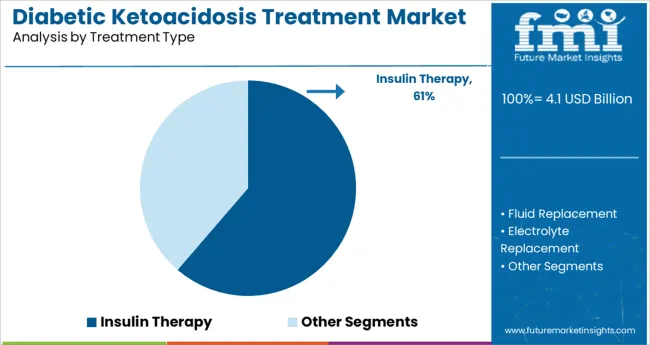
The insulin therapy segment is projected to hold 61.3% of the diabetic ketoacidosis treatment market revenue in 2025, maintaining its position as the leading treatment type. This segment’s growth is supported by the established role of insulin in correcting hyperglycemia and ketosis effectively. Insulin therapy remains the cornerstone of diabetic ketoacidosis management due to its ability to rapidly restore normal metabolic function.
Clinical protocols consistently prioritize insulin administration alongside fluid and electrolyte replacement to stabilize patients. The development of more precise insulin dosing regimens and improved delivery methods has also contributed to segment growth.
Insulin therapy’s efficacy and critical role in acute care ensure its continued dominance in the diabetic ketoacidosis treatment landscape.
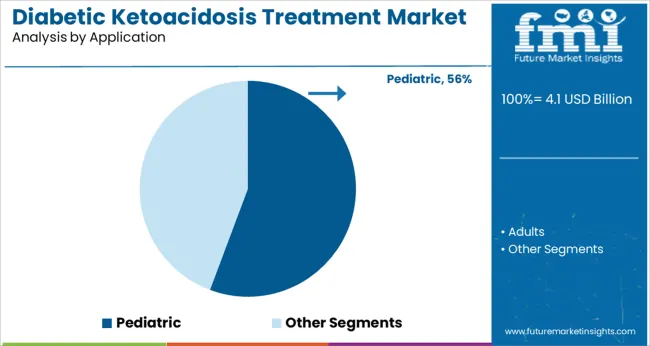
The pediatric segment is expected to account for 55.7% of the market revenue in 2025, positioning it as the leading application category. This prominence is linked to the relatively high incidence of diabetic ketoacidosis among children and adolescents with type 1 diabetes. Early diagnosis and management are critical in this age group to prevent complications and hospitalizations.
Pediatric healthcare providers have adopted specialized treatment protocols tailored to the unique physiological and psychological needs of younger patients. Awareness campaigns and improved screening have facilitated timely intervention in pediatric populations.
The focus on reducing mortality and improving quality of life in children with diabetes supports sustained growth in this segment.
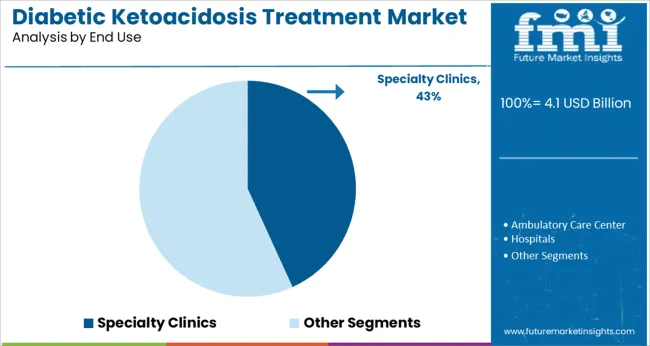
Specialty clinics are projected to contribute 43.2% of the diabetic ketoacidosis treatment market revenue in 2025, retaining their role as the primary care setting. These clinics offer focused diabetes management and acute care services, providing expertise and continuous monitoring that are vital for diabetic ketoacidosis patients.
The increasing establishment of specialty centers dedicated to endocrine and metabolic disorders has improved patient outcomes through comprehensive care models. Specialty clinics facilitate early diagnosis, prompt treatment initiation, and ongoing patient education, which help reduce recurrent episodes.
Their growing presence and the shift toward outpatient management for suitable cases have strengthened this segment’s market share. Specialty clinics remain essential for delivering targeted and effective diabetic ketoacidosis treatment.
The high demand for more efficient technologies and drugs for the treatment and management of diabetic ketoacidosis is projected to bolster the market in the evaluation period. The increasing awareness about the availability of various unique products for the treatment of this condition is another crucial factor that is anticipated to bode well for the diabetic ketoacidosis treatment market growth.
The rising number of several pharmaceutical companies in both developed and developing countries is also likely to drive the market. The rapid adoption of novel treatment facilities by numerous medium and small healthcare centers, as well as hospitals is estimated to spur the growth.
The lack of advanced treatment options and awareness about diabetic ketoacidosis in emerging economies may obstruct the market in the assessment period. Adverse side effects associated with the treatment of this condition can also hamper the graowth.
Adjustment of the blood sugar level at a rapid pace by using insulin and fluids can cause swelling in the brain. At the same time, it can lead to impair activities of the nervous system, muscles, and heart, as well as a drop in potassium level in the blood.
Besides, the requirement of constant monitoring of insulin levels and the unavailability of skilled healthcare professionals in remote areas are anticipated to negatively affect the sales of diabetic ketoacidosis treatment options. The limited availability of innovative facilities in multiple healthcare centers and hospitals can hinder the market.
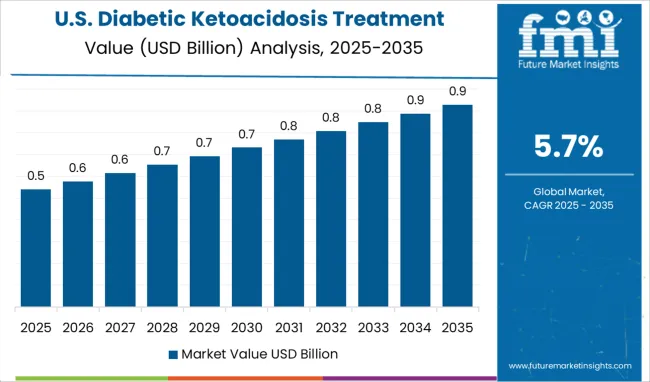
The rising cases of diabetes among the population in Canada and the USA are projected to fuel the North America diabetic ketoacidosis treatment market share. According to the Centers for Disease Control and Prevention (CDC), in the U.S., nearly 37.3 million people have diabetes and 8.5 million adults are undiagnosed. These numbers are estimated to surge in the future years, thereby driving the North America market.
The presence of favorable reimbursement scenarios and the increasing awareness regarding the early diagnosis of this condition are likely to accelerate the market. The availability of cutting-edge treatment options and the entrance of several renowned companies in this region are also set to propel the market.
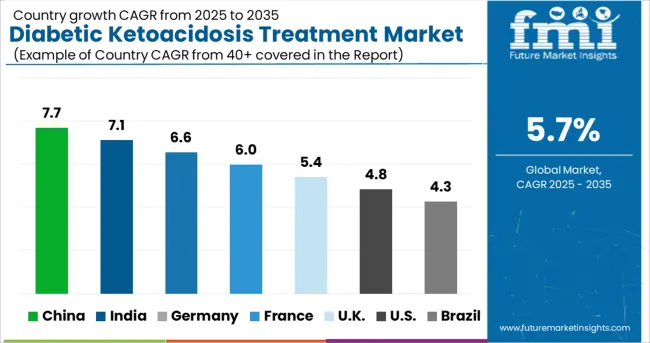
Asia Pacific is expected to remain in the second position and exhibit a steady diabetic ketoacidosis treatment market growth. The rising incidence of type 1 diabetes and the surging adoption of sedentary lifestyles are projected to augur well for the market.
The high geriatric population and the increasing adoption of effective strategies by leading companies based in China and India are some of the other crucial factors that are likely to aid the growth. The surging usage of insulin therapy backed by the ongoing advancement in the field of insulin delivery technique is another factor that is likely to augment the regional market.
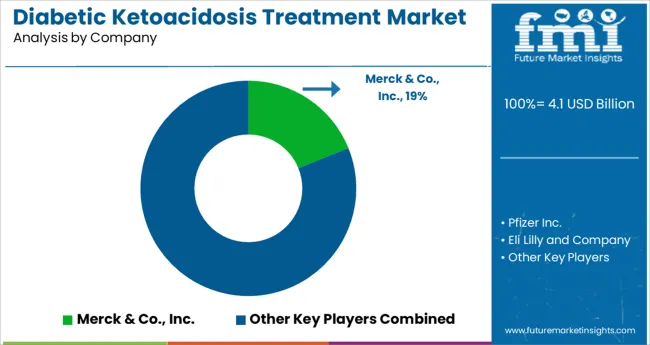
Some of the prominent companies operating in the global diabetic ketoacidosis treatment market include Merck & Co., Inc., Novo Nordisk A/S, Eli Lilly and Company, Biocon Limited, Wockhardt Ltd., Sanofi S.A., Bristol Myers Squibb, Tonghua Dongbao Pharmaceutical Co., Ltd., GlaxoSmithKline plc, Oramed Pharmaceuticals Inc., and Pfizer Inc. among others.
Some of the leading players are engaging in partnerships and collaborations with renowned companies to co-develop new treatment options and gain fast track approvals from regulatory bodies. Meanwhile, a few other players are increasingly focusing on broadening their existing product portfolios and expanding their geographic presence to fulfill the high unmet demand worldwide.
| Report Attribute | Details |
|---|---|
| Growth Rate | CAGR of 5.7% from 2025 to 2035 |
| Base Year for Estimation | 2024 |
| Historical Data | 2020 to 2024 |
| Forecast Period | 2025 to 2035 |
| Quantitative Units | Revenue in billion, Volume in Kilotons and CAGR from 2025 to 2035 |
| Report Coverage | Revenue Forecast, Volume Forecast, Company Ranking, Competitive Landscape, Growth Factors, Trends and Pricing Analysis |
| Segments Covered | Treatment Type, Application, End User, Region |
| Regions Covered | North America; Latin America; Western Europe; Easter Europe; APEJ; Japan; Middle East & Africa |
| Key Countries Profiled | USA, Canada, Brazil, Argentina, Germany, UK, France, Spain, Italy, Nordics, BENELUX, Australia & New Zealand, China, India, ASEAN, GCC, South Africa |
| Key Companies Profiled | Merck & Co., Inc.; Novo Nordisk A/S; Eli Lilly and Company; Biocon Limited; Wockhardt Ltd.; Sanofi S.A.; Bristol Myers Squibb; Tonghua Dongbao Pharmaceutical Co., Ltd.; GlaxoSmithKline plc; Oramed Pharmaceuticals Inc.; Pfizer Inc. |
| Customization | Available Upon Request |
The global diabetic ketoacidosis treatment market is estimated to be valued at USD 4.1 billion in 2025.
It is projected to reach USD 7.2 billion by 2035.
The market is expected to grow at a 5.7% CAGR between 2025 and 2035.
The key product types are insulin therapy, fluid replacement and electrolyte replacement.
pediatric segment is expected to dominate with a 55.7% industry share in 2025.






Full Research Suite comprises of:
Market outlook & trends analysis
Interviews & case studies
Strategic recommendations
Vendor profiles & capabilities analysis
5-year forecasts
8 regions and 60+ country-level data splits
Market segment data splits
12 months of continuous data updates
DELIVERED AS:
PDF EXCEL ONLINE
Diabetic Macular Edema Market Forecast and Outlook 2025 to 2035
Diabetic Nephropathy Market Size and Share Forecast Outlook 2025 to 2035
Diabetic Markers Market Size and Share Forecast Outlook 2025 to 2035
Diabetic Shoes Market Growth - Trends & Forecast 2025 to 2035
Diabetic Retinopathy Market Analysis - Size, Share & Forecast 2025 to 2035
Diabetic Food Market Report – Trends & Innovations 2025-2035
Diabetic Assays Market
Diabetic Pen Cap Market
Diabetic Retinopathy Treatment Market Size and Share Forecast Outlook 2025 to 2035
Antidiabetics Market Overview - Growth, Demand & Forecast 2024 to 2034
Foot Care For Diabetic Patients Market Size and Share Forecast Outlook 2025 to 2035
Necrobiosis Lipoidica Diabeticorum Market Size and Share Forecast Outlook 2025 to 2035
Treatment-Resistant Hypertension Management Market Size and Share Forecast Outlook 2025 to 2035
Treatment-Resistant Depression Treatment Market Size and Share Forecast Outlook 2025 to 2035
Treatment Pumps Market Insights Growth & Demand Forecast 2025 to 2035
Pretreatment Coatings Market Size and Share Forecast Outlook 2025 to 2035
Air Treatment Ozone Generator Market Size and Share Forecast Outlook 2025 to 2035
CNS Treatment and Therapy Market Insights - Trends & Growth Forecast 2025 to 2035
Seed Treatment Materials Market Size and Share Forecast Outlook 2025 to 2035
Acne Treatment Solutions Market Size and Share Forecast Outlook 2025 to 2035

Thank you!
You will receive an email from our Business Development Manager. Please be sure to check your SPAM/JUNK folder too.
Chat With
MaRIA